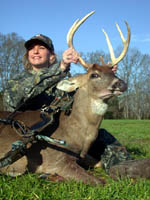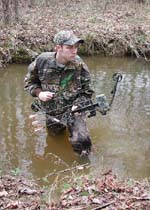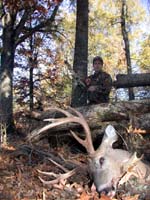
|
Features
|
|
|
|
Books
|
|
|
|
Fun & Games
|
|
|
|
Contact Us
|
|
|
John's Journal... Entry 219, Day 1
FIVE MOST CRITICAL INGREDIENTS TO BAGGING A DEER WITH A BOW
Brad Harris
 Editor's
Note: Almost every bowhunter I know considers one of these five ingredients-the
wind, the availability of food, the rut, the weather and hunting pressure-as
the most-critical element of successful bow hunting. However, you really
must take into account all five factors if you plan to back a buck with
your bow. Here, five of the nation's most successful bowhunters pick the
ingredient they consider most important to their success and explain the
reasons for their selection. Brad Harris of Neosho, Missouri, a longtime
avid deer hunter and video personality, takes trophy bucks with his bow
each year. To successfully arrow bucks for the video camera, Harris believes
he has to have the right wind.
Editor's
Note: Almost every bowhunter I know considers one of these five ingredients-the
wind, the availability of food, the rut, the weather and hunting pressure-as
the most-critical element of successful bow hunting. However, you really
must take into account all five factors if you plan to back a buck with
your bow. Here, five of the nation's most successful bowhunters pick the
ingredient they consider most important to their success and explain the
reasons for their selection. Brad Harris of Neosho, Missouri, a longtime
avid deer hunter and video personality, takes trophy bucks with his bow
each year. To successfully arrow bucks for the video camera, Harris believes
he has to have the right wind.
 The
wind is the most-critical key to taking a buck with a bow. Often, a buck
will hear or see you but won't be spooked. But if he smells you, he'll
leave the country. To keep a buck from smelling you, hunt with the wind
in your face or in a crosswind to blow your human odor away from a buck.
I rely on the wind more than any other factor for bagging a buck with
my bow. I look for days either with no wind, which are rare, or days with
a constantly prevailing wind. I prefer to hunt a day when the wind blows
continuously in one direction, especially on a day when I'm hunting trophy
bucks. I'm an avid viewer of "The Weather Channel" on TV. If I see a front
blowing in from the north or the west, then I feel confident I'll have
a prevailing wind pushing that front. However, I don't rely totally on
the TV forecast to learn wind direction. I use some type of wind indicator-powder,
a string, a feather, a cigarette lighter or another device to regularly
check the wind. If you hunt an older-age-class buck and he smells you,
more than likely you won't be able to hunt that buck in that place again
that season.
The
wind is the most-critical key to taking a buck with a bow. Often, a buck
will hear or see you but won't be spooked. But if he smells you, he'll
leave the country. To keep a buck from smelling you, hunt with the wind
in your face or in a crosswind to blow your human odor away from a buck.
I rely on the wind more than any other factor for bagging a buck with
my bow. I look for days either with no wind, which are rare, or days with
a constantly prevailing wind. I prefer to hunt a day when the wind blows
continuously in one direction, especially on a day when I'm hunting trophy
bucks. I'm an avid viewer of "The Weather Channel" on TV. If I see a front
blowing in from the north or the west, then I feel confident I'll have
a prevailing wind pushing that front. However, I don't rely totally on
the TV forecast to learn wind direction. I use some type of wind indicator-powder,
a string, a feather, a cigarette lighter or another device to regularly
check the wind. If you hunt an older-age-class buck and he smells you,
more than likely you won't be able to hunt that buck in that place again
that season.
 Usually
the stronger the front and the faster the front's moving, the more wind
there'll be, and the more dependable the forecast will be. I prefer to
hunt on windy days. The wind in the trees and the limbs disguises my movements,
and the noise of the wind masks any noises I may make. One of the biggest
mistakes deer hunters often make is to hunt stands when they know the
wind conditions aren't right to hunt from those stands. If you have any
doubt whether or not the wind will be ideal to hunt a particular area,
then don't hunt for that stand that day.
Usually
the stronger the front and the faster the front's moving, the more wind
there'll be, and the more dependable the forecast will be. I prefer to
hunt on windy days. The wind in the trees and the limbs disguises my movements,
and the noise of the wind masks any noises I may make. One of the biggest
mistakes deer hunters often make is to hunt stands when they know the
wind conditions aren't right to hunt from those stands. If you have any
doubt whether or not the wind will be ideal to hunt a particular area,
then don't hunt for that stand that day.
To learn more about master deer hunters, click here for John Phillip's deer-hunting books.
TOMORROW: RAY McINTYRE
Check back each day this week for more about FIVE MOST CRITICAL INGREDIENTS TO BAGGING A DEER WITH A BOW ...
Day 1 - Brad Harris
Day 2 - Ray McIntyre
Day 3 - Will Primos
Day 4 - Mark Drury
Day 5 - Hank Hearn